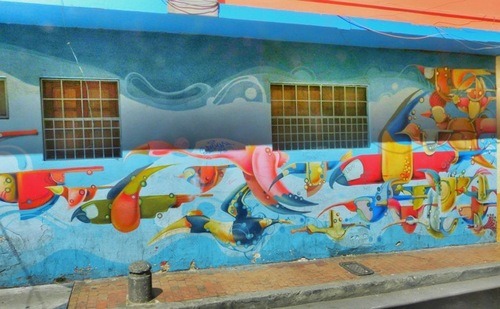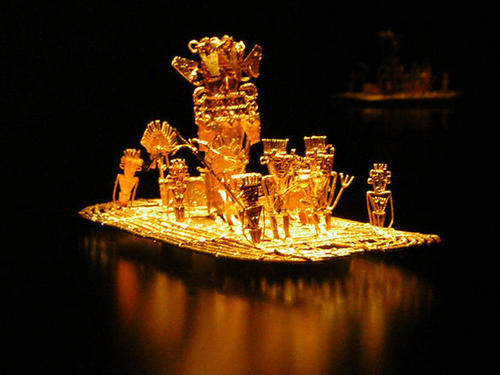Warning: If you ever take a night bus in Colombia, don’t forget to layer your clothing. Wear a hat, scarf, mitts, parka, blankets and sleeping bag. Consider bringing your own radiator.
I took a night bus from Medellín to Bogotá (9 hours?), and as you may have guessed, the ride was unfairly cold. For some reason they think it is appropriate to blast the AC for the whole ride, and I’m fairly certain it was 4 degrees celsius the whole time.
You hear a lot of banter comparing Medellín to Bogotá , with Medellín usually coming out on top, and Bogota disregarded as an oversized metropolitan hub.You may deduce from my previous post that I thought Medellín was magical, but my experience in Bogotá was just as unique and wonderful. That being said, Medellín certainly has a better public transportation system. In Bogotá , city buses are ubiquitous, but you need to purchase a bus card onto which you deposit money. To make things more confusing, there are different coloured cards for different routes, and I never figured out which cards are for what.
Everyone I had met advised to me to stay in Candelaria, the historic centre and oldest neighborhood in the city. Candelaria is adjacent to the ‘downtown’ and is filled with old colonial buildings and museums. It also more recently has developed into the artsy, bohemian neighborhood, featuring live music, graffiti (more on that later), upscale bakeries, and ultrahip little boutiques, while retaining the old colonial feel. I stayed at Musicology Hostel (18000 pesos, includes breakfast), and the Candelaria neighborhood was right up my alley (bad pun, har har).
Note: Unfortunately Candelaria is not within walking distance of the bus terminal. You’ll need to either take a cab, or be like me and wander around pestering locals for directions until you eventually find the right bus. This gringa is not afraid of asking for directions.
I knew I only had a limited amount of time in Bogotá so immediately after checking in, I embarked on a journey to the Catédral de Sal, or Salt Cathedral, located in the neighboring town of Zipaquira (to get there, you’ll need to make your way to Portal del Norte bus station. If you are coming from Candelaria, take the B74 bus from the Las Aquas stop (red card). Once at Portal del Norte hop on a bus to Zipa). The ride took me a little over an hour. Zipaquira is a charming colonial settlement, with the Salt Cathedral taking up a hillside on the edge of town. General admissions to the cathedral costs about 22,000 pesos and includes a guided tour, light show, and 3D film. For some reason, in my mind I was expecting a cathedral made of salt. No, the cathedral is essentially a converted salt mine with symbols of Christ and places of worship added into the underground tunnels and chambers. Walking into the cool, colourfully lit, underground chambers was exhilarating. The guided tour however, not so much. The guide struggled with his English, and as a result, I struggled in understanding him. Most of what I did pick up from the tour was along the lines of how some rocks represented Mary Magdelene and the Virgin Mary, and how Jesus’s face could be seen in a hole in the wall (Oh look, Jesus’s face is also in my cheese sandwich).

Figure 1. Inside the Catédral de Sal. The sculpture is a replica of Michelangelo’s ‘Creation of Man’.
Unsatisfactory tour aside, I was still thrilled to be in the cathedral. The 3D film wasn’t anything particularly special but had some good information on the history of the area and subtitles in English. After a few hours of wandering, I made my way back to Bogotá (Note: To get back to Las Aguas from Portal de Norte, take the J72. I don’t know why you take the B line on the way there and the J line back).
In Bogotá there is no need to line up at a museum to see incredible artwork; it can be found on the way to the grocery store, during the walk to the bus station, or even just outside your window. Exceptional street art has blossomed in this city, and you can learn about it in further detail by participating the ‘free’ Graffiti Tour (by donation). This was the highlight of my visit to Bogotá . The two and a half hour tour incorporates all forms of street art (mixed media, muralism, sculpture, graffiti, etc.), introduces prominent artists of the area, and interprets many of the pieces. Candelaria is special in that about half of the artwork you see is by commission. The neighborhood is very open to freedom of expression, and many illegal pieces are left up simply because of their aesthetic appeal. There is something inspiring about beautifying your everyday streets simply for the sake of it. I think it is a special gift and pleasure to see inspirational artwork in your typical, everyday street.

Figure 2. One of my favourite pieces done by artist Rodez.

Figure 3. Another incredible piece of street art done by graffiti collective APC. The girl in the bottom left corner is done by artist Stinkfish, and I regrettably forget the names of the other two artists.
On the contrary, if you do feel like going to a museum to see artwork, Museo Botero (located close by at Calle 11 and Carrera 5) is a great option. This gallery is free and features artwork from Colombia’s own Fernando Botero, as well as some other artists such as Picasso and Renoir. Some other museums are adjacent to the gallery, although time did not permit me to visit them.

Figure 4. Botero’s interpretation of the Mona Lisa.
Bogotá is also home to the country’s largest collection of gold artifacts, which you can tour at the Museo del Oro or Gold Museum. When I say large collection, it really is quite a large collection. The museum is divided into 4 exhibits: the working of metals, people and gold in pre-Hispanic Colombia, cosmology and symbolism, and the Offering. All exhibits are completely filled with gold, and I took roughly three hours to see everything.

Figure 5. Gold figurine of El Dorado. El Dorado means ‘golden one’ and refers to a Muisca chief who would cover himself in gold powder and dive into Lake Guatavita from a raft. He would also throw gold and precious gems overboard as an offering to the Gods. The figurine depicts El Dorado as the big guy in the centre, surrounded by high-ranking shamans. Lake Guatavita is located close to Bogota and can still be visited today, although I don’t think very many gold artifacts were discovered there.
After two and a half days, I was very sad to leave Bogotá and return to Quito. For those that have more time, the Free Biking Tour is a popular activity, as well as visiting Monserrate, the gondola system that offers great views of the city.